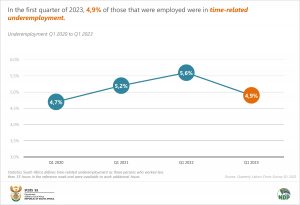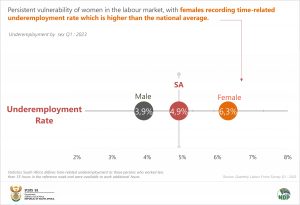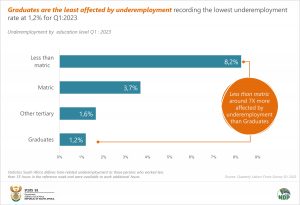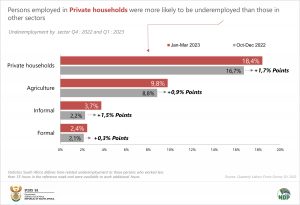Beyond unemployment – Time-Related Underemployment in the SA labour market
South Africa’s unemployment rate in the first quarter of 2023 was recorded at 32,9 %, and is among the highest in the world. According to the Quarterly Labour Force Survey (QLFS), this is an increase of 0,2 of a percentage point compared to the fourth quarter of 2022.
While the unemployment rate may be high, there is also an increase in time-related underemployment. Time-related underemployment refers to all persons in employment who (i) wanted to work additional hours, (ii) had worked less than a specified hours threshold (working time in all jobs), and (iii) were available to work additional hours given an opportunity for more work. Statistics South Africa defines time-related underemployment as those persons who worked less than 35 hours in the reference week and were available to work additional hours.
Time-related underemployment rate is defined as the percentage of time-related underemployed persons to employed persons. In the first quarter of 2023, 4,9% of employed persons were in time-related underemployment. This is consistent with underemployment recorded in Q1:2020 pre-COVID-19 with a slight increase of 0,2 of a percentage point over these years. The prevalence of underemployment increased during COVID-19, increasing from 4,7 % in Q1:2020 to 5,2% in Q1:2021, followed by a significant increase in the proportion of persons affected by time-related underemployment in the first quarter of 2022 at 5,6%.
Quarter-to-quarter changes indicate an increase by 0,5 of a percentage point in time-related underemployment, from 4,4% in Q4:2022 to 4,9% in Q1:2023. Although the underemployment rate increased for both females and males, females were more likely to be in time-related underemployment (6,3%) than their male counterparts (3,9%). Also notable is the persistent vulnerability of women in the labour market, with the time-related underemployment for females being higher than the national average. Females may desire to work more hours; however, various reasons may force them to work fewer hours than they desire: their disproportionate care work could make them less likely to be available to work more hours or take up an extra job; there may be other family responsibilities and commitments; or they may be discouraged to a greater extent in their job search compared to their male counterparts.
With the highest time-related underemployment rate of 5,9%, Black Africans remain vulnerable in the SA labour market as they desire to work more hours. Indian/Asian and White population groups have the lowest time-related underemployment rates (0,9% each). The only decrease in time-related underemployment was recorded among the Indian/Asian population group (1,7 percentage points).
With the exception of Free State, which showed a decline of 1,7 percentage points quarter-on-quarter, all other provinces recorded an increase in the percentage of people affected by time-related underemployment. Employed persons from Limpopo, Eastern Cape and Mpumalanga recorded the highest prevalence of time-related underemployment. Western Cape, North West and Gauteng recorded the lowest underemployment rate in the first quarter of 2023.
Graduates are the least affected by underemployment, recording the lowest underemployment rate at 1,2% for Q1:2023
As with the unemployment rate, young people experience underemployment at far higher rates than older persons. For the first quarter of 2023, the underemployment rate was 6,3% for those aged 15-24 and 5,2% for those aged 24-34, which is higher than the national rate of 4,9%. The lowest underemployment rate is recorded in the age groups 35-44 years and 55-64 years, both at 4,6%.
Persons employed in Private households were more likely to be underemployed than those in other sectors. The underemployment rate for those employed in Private households was 18,4% in Q1:2023 and 16,7% in Q4:2022, an increase of 1,7 percentage points quarter-on-quarter. Agriculture recorded the second highest underemployment rate at 9,8% in Q1:2023 and 8,8% in Q4:2022.
The 19th International Conference of Labour Statisticians (19th ICLS) defines labour underutilisation as the mismatches between labour supply and demand, which translates into an unmet need for employment among the population. An important component of labour underutilisation is time-related underemployment, which can bolster the analysis of the labour market’s effectiveness. The international standard defines persons in time-related underemployment as all persons in employment who, during a short reference period, wanted to work additional hours, whose working time in all jobs was less than a specified hours threshold, and who were available to work additional hours given an opportunity for more work.
According to the latest data, the first quarter of 2023 indicates an increase in the prevalence of time-related underemployment. Statistics on time-related under-employment are useful as a supplement to information on employment and unemployment, particularly the latter, as they enrich an analysis of the efficiency of the labour market in terms of the ability of the country to provide full employment to all those who want it.[1]
For more information download the Quarterly Labour Force Survey here.
[1]https://www.ilo.org/global/statistics-and-databases/research-and-databases/kilm/WCMS_422452/lang–en/index.htm





